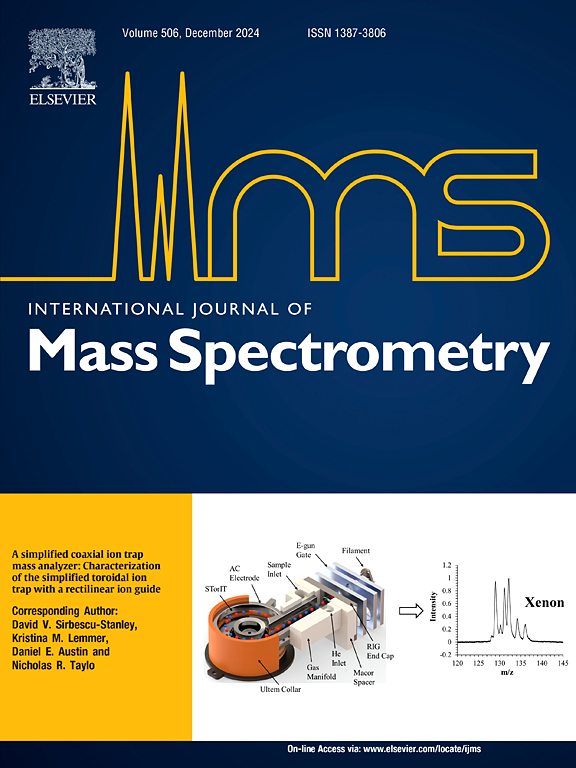2020年武汉市新型冠状病毒肺炎应对医院挥发性有机物排放动态质子转移反应质谱分析
IF 1.7
3区 化学
Q3 PHYSICS, ATOMIC, MOLECULAR & CHEMICAL
引用次数: 0
摘要
为遏制新冠肺炎疫情的快速传播,武汉于2020年1月23日在全球率先实施严格的封锁措施,并迅速建立了几家大型医院。这些医院内广泛的消毒操作和日常活动导致大量挥发性有机化合物(VOCs)的释放。然而,这些医院周围VOCs的组成和浓度特征尚不清楚。本研究采用自主研发的移动质子转移反应质谱(M-PTR-MS)系统,于2020年2月29日至3月15日对武汉市上述医院的VOCs进行了高时空分辨率的移动监测。本研究比较了武汉市各地区VOC的时空变化,重点研究了临时医院(雷神山医院)、定点医院(武汉协和医院、武汉金银坛医院)和方棚医院(武汉京亭方棚医院、红山体育馆方棚医院)顺风方向VOC增加的频率和浓度。结果表明:在有效移动监测的14 d内,前7 d总挥发性有机化合物(TVOC)平均浓度比后7 d高13.39%;从空间上看,长江以北工业区的TVOC平均浓度比长江以南非工业区高8.89%;雷神山医院挥发性有机化合物的组成和来源最为多样化,挥发性有机化合物主要来自医院场地内发酵和直接焚烧的医疗废物和消毒剂。在定点医院下风方向,检测到与工业源、消毒剂、废弃物有关的VOCs。所有这些医院的下风处都检测到乙醇。医院产生的废物是临时医院和指定医院顺风处挥发性有机化合物的重要来源。本研究为突发公共卫生事件中VOC特性研究、消毒效果评价及环境影响分析提供了有价值的技术手段。本文章由计算机程序翻译,如有差异,请以英文原文为准。

Emissions of volatile organic compounds from COVID-19 response hospitals using mobile proton transfer reaction mass spectrometry observations in Wuhan in 2020
To curb the rapid spread of the COVID-19, Wuhan was the first in the world to implement strict lockdown measures on January 23, 2020, and rapidly established several large hospitals. The extensive disinfection operations and daily activities within these hospitals led to the release of significant amounts of volatile organic compounds (VOCs). However, the composition and concentration characteristics of VOCs around these hospitals remain unclear. This study employed a self-developed mobile proton transfer reaction mass spectrometry (M-PTR-MS) system to conduct high spatiotemporal resolution mobile monitoring of VOCs in these hospitals in Wuhan from February 29 to March 15, 2020. The study compared the temporal and spatial variations in VOC across Wuhan, focusing on the frequency and concentration of VOC increases downwind of temporary hospital (Leishenshan Hospital), designated hospitals (Wuhan Xiehe Hospital, Wuhan Jinyintan Hospital), and shelter hospitals (Wuhan Keting Shelter Hospital, Hongshan Stadium Shelter Hospital). The results indicated that during the 14 days of effective mobile monitoring, the average concentration of total VOC (TVOC) in the first seven days was 13.39 % higher than in the latter seven days. Spatially, the average concentration of TVOC in the industrial areas north of the Yangtze River was 8.89 % higher than those in the non-industrial areas south of the river. Leishenshan Hospital exhibited the most diverse VOC composition and sources, with VOCs primarily originating from the fermentation and direct incineration of medical, waste within the hospital grounds and disinfectants. Downwind of the designated hospitals, VOCs related to industrial-source, disinfectants and waste were detected. Ethanol was detected downwind of all these hospitals. Waste generated by hospitals was a significant source of VOCs downwind of both temporary and designated hospitals. This study provides valuable technology for the research on VOC characteristics, disinfection efficacy evaluation, and environmental impact analysis during public health emergencies.
求助全文
通过发布文献求助,成功后即可免费获取论文全文。
去求助
来源期刊
CiteScore
3.60
自引率
5.60%
发文量
145
审稿时长
71 days
期刊介绍:
The journal invites papers that advance the field of mass spectrometry by exploring fundamental aspects of ion processes using both the experimental and theoretical approaches, developing new instrumentation and experimental strategies for chemical analysis using mass spectrometry, developing new computational strategies for data interpretation and integration, reporting new applications of mass spectrometry and hyphenated techniques in biology, chemistry, geology, and physics.
Papers, in which standard mass spectrometry techniques are used for analysis will not be considered.
IJMS publishes full-length articles, short communications, reviews, and feature articles including young scientist features.

 求助内容:
求助内容: 应助结果提醒方式:
应助结果提醒方式:


